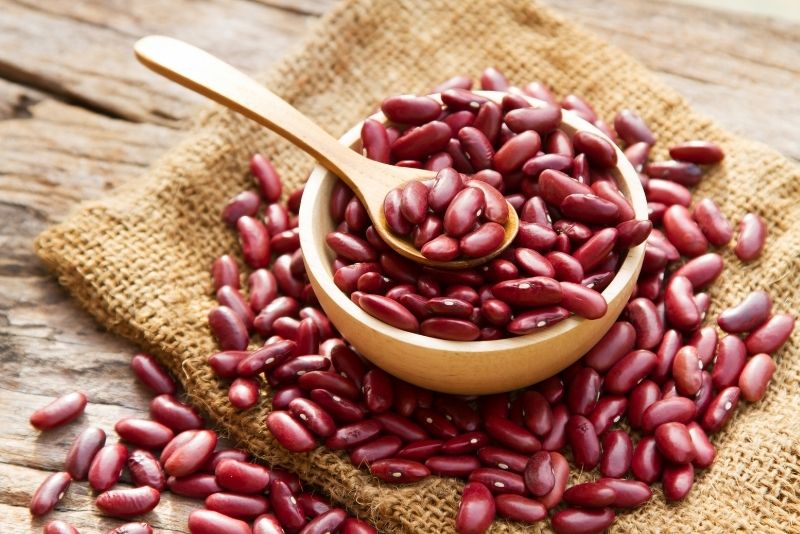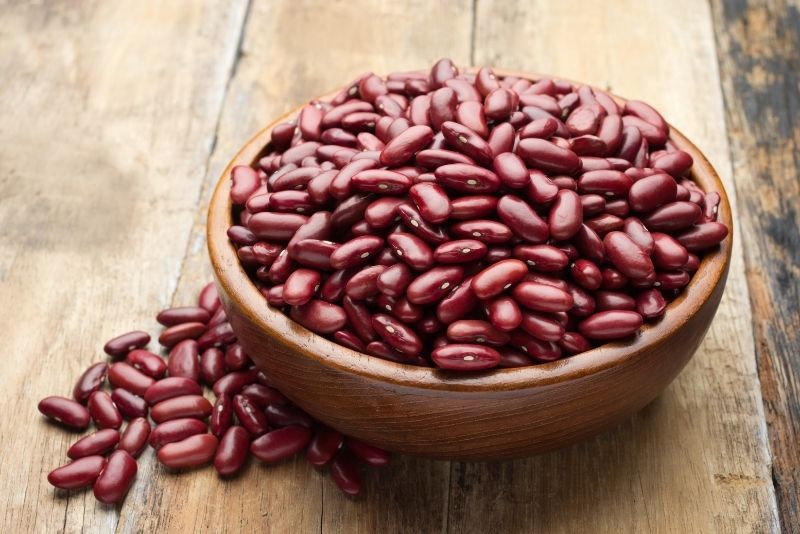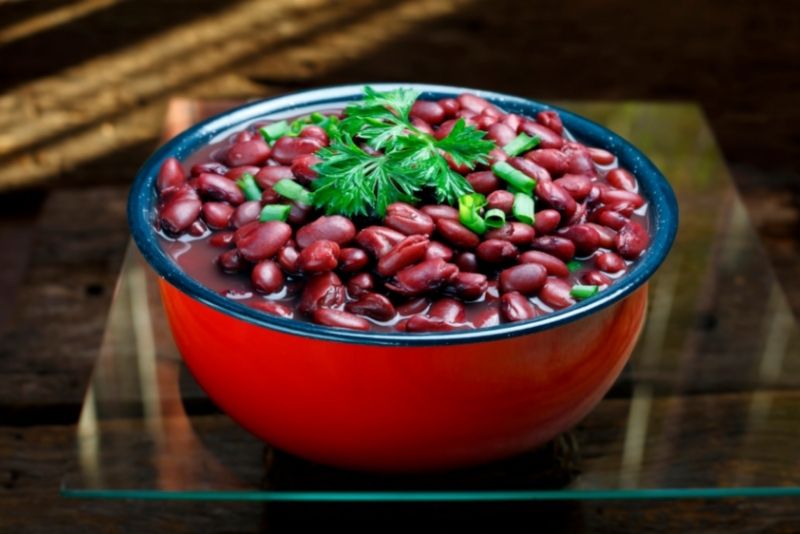A question that often comes up among my foodie friends is what exactly are the differences between red beans vs kidney beans? If you have got the same question, I am here to tell you everything!
Red beans are smaller in size, have a more pinkish-red color, and they are sweeter. Kidney beans are larger in size, have a more brownish-red color, and have a stronger flavor.
If you’re not sure which one to get next time at the grocery store just remember these important differences.
Table of Contents
Red Beans vs Kidney Beans: What is the Difference?
Factors | Red Beans | Kidney Beans |
Size | Smaller (1/2 inch in length) | Slightly larger |
Shape | Oval, oblong shape | Kidney-shaped |
Color or Apperance | Pinkish Red | Dark Red |
Texture | Smoother skin | Thick, less smooth skin |
Nutrition | Rich in iron and antioxidants | Good source of protein and minerals |
What Are Red Beans?

Red beans are small, oblong-shaped beans that are often confused with kidney beans. While they originated from Central America, today they can be found all over the world including many places in Asia.
In terms of appearance, Red Beans are red in color, have a smooth texture, and are typically around 1/2 inch in length. They will add a mild flavor to your recipe with a slightly nutty and sweet taste.
However, you can also eat them on their own as red beans are not only rich in antioxidants but also a good source of iron.
Red beans sometimes go by the name Mexican red beans and you can use them in a variety of recipes like rice, bean salads, soup, or chili.
What Are Kidney Beans?

Kidney beans are small, kidney-shaped beans that are often used in foods like chili or salads. They get their name because of their kidney-like shape.
Kidney beans are smaller than most other types of kidney beans, but they still have the same distinct dark red color. They are usually available in four different varieties:
- Red kidney beans
- Red speckled kidney beans
- Lightly speckled kidney beans
- Cannellini beans also known as White beans
Kidney beans taste slightly earthier than red beans but they’re still versatile enough to add to just about any dish you want.
There are a number of ways to cook kidney beans and some common recipes include chili, various curries, or even a classic and simple white bean and ham soup.
Do note that raw or uncooked kidney beans are toxic so they shouldn’t be consumed on their own. I’ve shared more details about this in the FAQ section below.
Differences Between Red Beans vs Kidney Beans
There is a number of differences between red beans vs kidney beans that include shape, size, and flavor.
Red beans are smaller, rounder, and oval in shape, while red beans are larger in size and are kidney-shaped.
In terms of flavor, red beans are slightly sweeter than kidney beans, which have a stronger flavor. Red beans are typically red in color with smoother skin, while kidney beans are browner and have thick skin around them.
Another important difference is that red beans can be cooked without presoaking them for an hour beforehand but it’s recommended to soak the kidney beans before cooking.
Whereas red beans will take 20-25 minutes to cook, kidney beans usually take 35-40 minutes to cook through completely until they are soft enough to mash up for refried bean dip or use as whole pieces in Mexican dishes like burritos or tacos.
They both can be used interchangeably in recipes meaning that you will taste no difference if one is substituted for the other. The only drawback is that kidney beans soak up more water.
Differences aside, both red beans vs kidney beans are full of nutrition and an excellent source of fiber.
If your body requires iron and antioxidants, you should include more red beans in your diet. Whereas, if you need more minerals and protein, kidney beans will be more suitable.
What’s more, you can use both in recipes like rice, soup, and chili. However, as I said before, red beans can be eaten on their own (or in bean salad) but kidney beans are toxic if consumed raw or uncooked.
Red Beans vs Kidney Beans Nutrition
One cup of cooked red beans will have 294 calories, 16.8g fiber, 17.3g proteins, and 1g of fat.
On the other hand, one cup of cooked kidney beans will have 219 calories, 16.5g fiber, 16.2g proteins, and 0.5g of fat.
Below is a table comparing the % RDI (Recommended Dietary Intake) for both red beans vs kidney beans if you were to consume it daily.
Red Beans Nutrition | Kidney Beans Nutrition | |
Copper | 34% | 26% |
Folate (vitamin B9) | 70% | 33% |
Iron | 26% | 29% |
Magnesium | 30% | 21% |
Phosphorus | 39% | 24% |
Potassium | 35% | 21% |
Thiamine (vitamin B1) | 18% | 15% |
Vitamin B6 | 11% | 9% |
Zinc | 27% | 10% |
Red Beans vs Kidney Beans Taste
Both red beans and kidney beans are packed with aroma and unique flavor profiles. When used in a recipe, red beans will add a slightly sweeter, “beany” flavor to it whereas kidney beans will absorb the flavor of other ingredients used.
Red beans have a more supple texture than kidney beans, which are firmer. When cooked, both these beans will retain their shape and firmness adding to the presentation of your dish.
While it’s up to an individual’s preference, red beans supposedly taste better when served cold and kidney beans have enhanced flavor profile in hot or warm dishes.
Red Beans Substitutes
If you’re looking to substitute red beans in a recipe, look for other types of small and round legumes such as black-eyed peas or pinto beans.
If you come across any other larger beans like lentils or navy beans, those could also work as substitutes as well as rice (for gumbo) and potatoes (for baked beans).
Kidney Beans Substitutes
If you’re looking to substitute kidney beans in a recipe, it’s best to be safe and stick with other types of large red or brownish-colored legumes such as chickpeas, black beans, or pinto beans.
If that fails, rice (for chili) and potatoes (for baked beans) will work well too!
FAQ:
Now that I have discussed almost everything you should possibly know about red beans vs kidney beans, let’s take a look at some frequently asked questions.
Can I Substitute Kidney Beans for Red Beans?
Yes! You can substitute kidney beans for red beans in most recipes. They both have their own unique tastes and textures, but they can be easily swapped in recipes without much of a difference.
Just know that if you are using red beans, they will add a slightly sweeter taste to your dish whereas if you are using kidney beans, they will absorb the flavors of other ingredients in the recipe.
Red Beans or Kidney Beans for Chili?
Kidney beans are an excellent choice for chili because of their ability to absorb spices and flavors easily. They maintain their shape when cooked, go well with cayenne pepper (and other hot sauces), and are also used in red bean paste.
However, if you don’t want kidney beans or can’t find them at your grocery store, you could substitute them with pinto or black-eyed peas instead.
Are Red Beans Dangerous?
Toxicity is a very common but dangerous side effect of eating raw kidney beans. If you eat raw, soaked kidney beans either alone or in salads and casseroles it is possible to experience toxic symptoms.
People who have reported experiencing these side effects include those who cooked their beans on low heat for an extended period of time with no added ingredients like salt or pepper; this includes slow cooker recipes too!
Toxins in raw kidney beans can trigger symptoms of toxicity within one to three hours. Nausea and vomiting with diarrhea follow after consumption, though the severity decreases over time as your body processes it through other organs.
